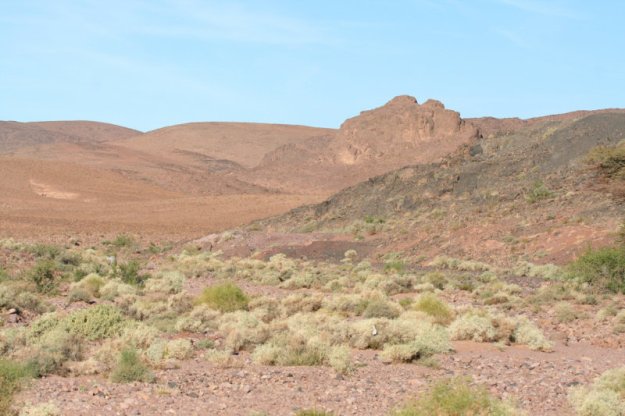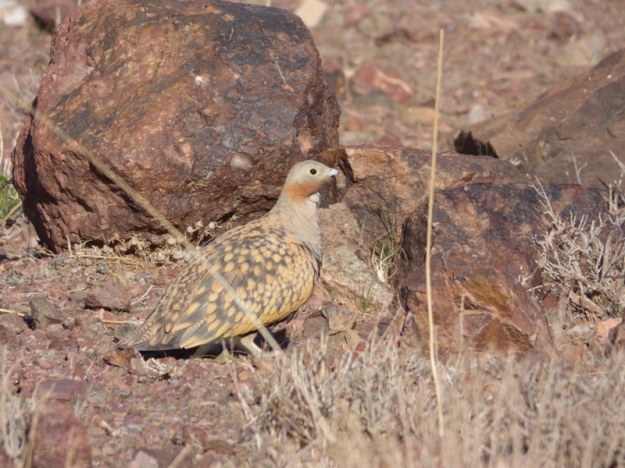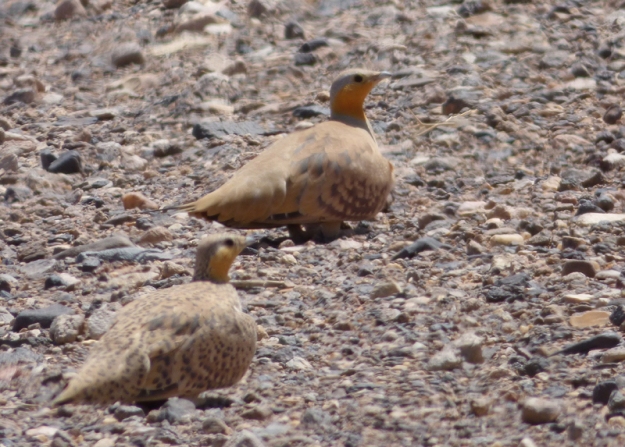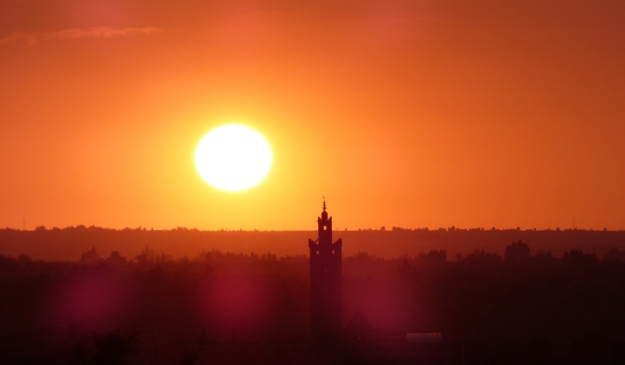Dates: from 20th March to 29th March, 2017
Number of participants: 5
Number of seen species: 190 + 6 races
This is the official trip report of the early spring Moroccan tour, 2017 issue, by Barcelona Birding Point and led by Carles Oliver. It has been our 4th edition and, I have to say, probably the most successful so far.

Spotted Sandgrouse (Pterocles senegallus). 2017 has been an excellent year for Sandgrouse. We got terrific views in 3 different species. Photo by tour leader Carles Oliver
Day 1. As usual in this trip, all participants assembled in Marraquech during March 19th, arriving from different countries and cities so people had time to arrive tothe designated hotel during the afternoon or the evening.
For those of us arriving March 19th, the weather was not really friendly as a massive rain wellcomed us to a country which is normally having very pleasant weather conditions at this time of the year.
We all had a good breakfast and got a lot of energy to start our trip. Even from the car park, minute 1 of the tour, we had some good birds. Common Bulbul (Pycnonotus barbatus), House Bunting (Emberiza sahari) singing from the balconies of the hotel as well as good numbers of wonderful Pallid Swifts (Apus pallidus) flying around. A careful scanning of the swifts produced our firsts 3 Little Swifts (Apus affinis).
The orchads around produced Blackbird (Turdus merula), Eurasian Collared Dove (Streptopelia decaocto), House Sparrow (Passer domesticus), Common Wood Pigeon (Columba palumbus) and mating Common Kestrels (Falco tinnunculus). Even before we left the parking place we had a first surprise since a overflying Osprey (Pandion halieatos) took us all out of the van. Always nice to see them!
First transfer to Marrakech outskirts while enjoying some close ups to typical “road birds” such as Moroccan Wagtail (Motacilla subpersonata), White Stork (Ciconia ciconia) and Moroccan Magpie (Pica pica mauretanica), an endemic race to NW Maghreb and a good candidate for future splits. Our very first stop brought us to a poplar forest by the road.
Here, soon after leaving the van we were having really good views on the Moroccan race of Great Spotted Woodpecker (Dendrocopos major lucidus), easy to tell apart because of the large red cloud in the vental area, the blackish collar and the rather dirty white underparts. We had close views on two individuals as well as beautiful views on African Blue Tit (Cyanistes teneriffae ultramarinus) while hanging on the branches and chasing each other. Great Tit (Parus major), Greenfinch (Chloris chloris) and firsts Blackcaps (Sylvia atricapilla) and Chiffchaffs (Phylloscopus collybita) of the trip were also around.

High Atlas from Marraquech outskirts. Image by tour leader Carles Oliver.
2 Nightingales (Luscinia megarhynchos) were singing quite deep inside the forest so we didn’t try to have any approach to them. African Chaffinches (Fringilla coelebs africana) were also celebrated as we had close views while feeding on the ground. In the air, a mixed flock of Little Swifts and Red-rumped Swallows (Cecropis daurica) was also popular in the group while Cattle Egrets (Bulbulcus ibis) and White Storks were moving up & down the valley. A bit more of scanning was required to find the main target of this stop but, finally we got really close views on 2 Levaillant’s Green Woodpeckers (Picus vallantii), moving up in the trees and mating just ten metres from us!! To see this tip of behaviour is always a bonus!! Male was calling really close of us but still we could not find it. We moved some metres to the right and got excellent views on the male moving up the tree, just to meet a female in the next branch and go on for some work looking forward the next generation!!!
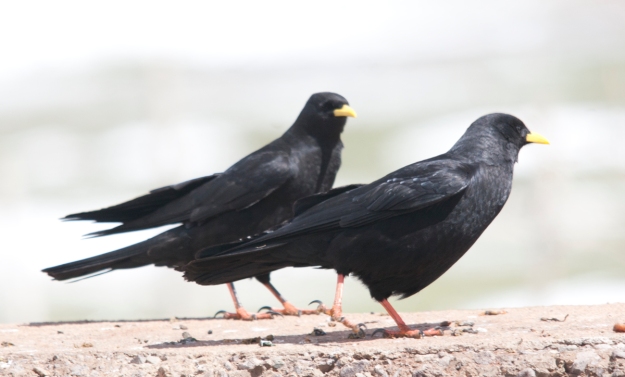
Alpine Choughs (Pyrrhocorax graculus) are a common view in High Atlas uplands. Image by Carles Oliver
After such a great start we just drove a pair of miles up the same road for a second stop. Even before arriving a road-stop was required since a Short-toed Eagle (Circaetus gallicus) was spotted in the sky. A really low bird, magnificient views. Numbers of Barn Swallows (Hirundo rustica) were moving North in a run to reach their nesting sites in Europe and 1 Willow Warbler (Phylloscopus trochilus) was fastly moving among the juniper trees.
Second stop of the trip to explore some open juniper scrub land. A short walk around the area fastly produced a good number of Blackcaps, the firsts views (of many in the trip) on Moussier’s Redstarts (Phoenicurus moussieri), Sardinian Warblers (Sylvia melanocephala) and very distant Common Cuckoo (Cuculus canorus) calling. No signal of our main target this time but still we flushed a solitary Barbary Partridge (Alectoris barbara) that almost everybody could enjoy. Before coming back to car we still decided to take a second look beyond. Some birds were calling in the distance…
After some minutes of walking we stop to scan the bush land. A shrub full of berries in front of us was having movement inside. Here we had excellent views on the inornata race of Subalpine Warbler (Sylvia cantillans), the race nesting in Morocco. A wonderful male showing really well. More movement inside the scrub, we waited a bit and then a superb male Tristam’s Warbler (Sylvia deserticola) was showing well, alongside with the Subalpine Warbler! It is always a pleasure to have two similar warblers together so everybody can compare differencies in structure and coloration.
We enjoyed the bird for some seconds before flusshed out the scrub… We still waited there some minutes and we got a second Tristam’s, noticiable because of the less contrasted coloration. That was definately a good start with really good views on an often tricky species. We still invested 10 minutes more around, trying to have better views (and photos) in the species but our efforts only produced Eurasian Robin (Erithacus rubecula).
Happy all with such a wonderful encounter, we start moving up the Atlas, enjoying the superb landscapes of endless rocky slopes contrasting with extremelly green crops in the lower, arid slopes. We still had another stop before heading up. A pair of small cliffs are hosting a colony of Lesser Kestrels (Falco naumanni) so we stopped to have good views on them. Unfortunately they seemed to not be all there (yet?) and we only had 1 male Lesser Kestrel flying plus and 3-4 Common Kestrels around. Still, the stop was not bad since we had good views on European Serin (Serinus serinus) and Tomas spotted a female Blue Rock Thrush (Monticola solitarius). Midway up we also had a first close-up to Black Wheatear (Oenanthe leucura), a wonderful bird only living in Iberia & Morocco. Other good birds were enjoyed in the road; Long-legged Buzzard (Buteo rufinus cirtensis), Thekla Lark (Galerida theklae) and Common Raven (Corvus corvus).
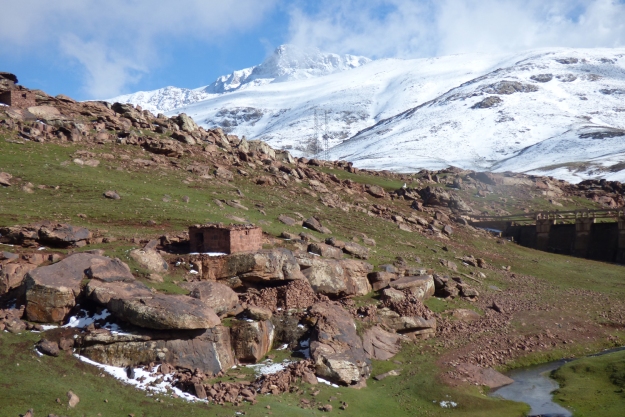
Massive high mountain landscape in the Atlas in the transition from alpine meadows to rocky slopes. Image by tour leader Carles Oliver
Once arrived to Oukaïmeden we first enjoyed the flocks of Choughs around. 100+ Alpine Choughs (Pyrrhocorax graculus) were joined by 30+ Red-billed Choughs (Pyrrhocorax pyrrhocorax) and we all had really close views on the birds! A short walk around produced beautiful views on 5 Common Rock Sparrows (Petronia petronia) as well as one of the few European forms of Common Chaffinch (Fringilla coelebs) of the trip! The slopes beyong were hosting several Black Redstarts (Phoenicurus ochruros) providing really good views on both males and type female birds. We still walk a bit more but we had no signal of the main targets of the area… When coming back to the car park we had 1 Atlas Horned Lark (Eremophila alpestris atlas), a race considered by some as a full species. This bird was landing on a slope beyond us and, just when we were about to leave, we got a flock of African Crimson-winged Finch (Rhodopechys alienus) feeding on the ground in that same slope! In half a second they went down the slope and we could have excellent views on, at least, 40 of them!! After some minutes of enjoyment we decided to go for lunch… we all deserve it!

African crimson-winged Finch (Rhodopechys alienus) is a Maghreb endemic and one of the most wanted species when visiting the Atlas. We enjoy 40+ of them. Image by tour leader Carles Oliver
After a food lunch and some rest we still came to the same spot where we had the finches hoping for a better views on Atlas Horned Larks… this was a not that easy task on a normally easy-to-find bird. Still, after some minutes of scanning, we found a really nice individual feeding on the ground and we all had good views of the bird in the scope. It was just feeding along with several African Crimson-winged Finches, enjoying again majestic views on these birds! Before leaving the high mountains we still had a pair of stops. First stop, by one stream, was producing Dipper (Cinclus cinclus) along with Grey-headed Wagtail (Motacilla flava flava), Blue Rock Thrush male, Black Wheatear and some Black Redstarts. The second stop was even more successful since we had really good views on Coal Tit (Periparus ater), Firecrest (Regulus ignicapillus), Greenfinch, Blackbird and the endemic race of Short-toed Treecreeper (Certhia brachydactyla mauretanica) that was showing really well and let us listen its really different song and calls several times. This race is, again, a good candidate for a future split.
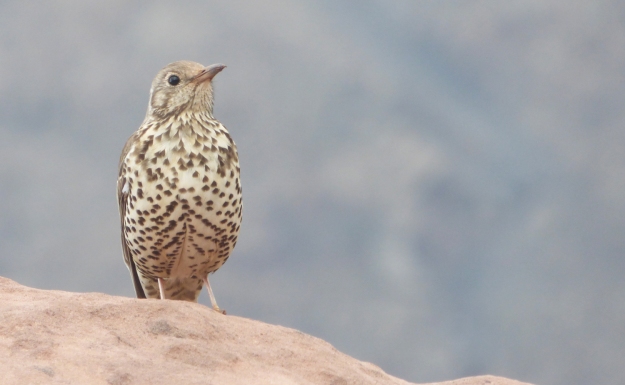
Mistle Thrushes (Turdus viscivorus deichleri) are smaller, slimmer and more contrasted than “European” forms and a good candidate for future split. Image by tour leader Carles Oliver
Other good birds here included good views on Mistle Thrushes (Turdus viscivorus deichleri) and 1 Hawfinch (Coccothraustes coccothraustes) that was singing up in the trees but only showed breefly by flying above us and disappear again in the canopies… The road down to Marrakesh only produced Cattle Egrets, White Storks and some more typical road birds until we stopped not far from the city, to enjoy a wonderful view on the mountains in the afternoon light. Here, a fast scanning in the fields produced a gorgeous Black-winged Kite (Elanus caeruleus) flying, hovering and hunting in the open fields!! Some scatered pairs are to be found all along this valley but they are normally difficult to spot. We could all enjoy the bird for over 5 minutes… An amazing view on an amazing bird!! A wonderful end for a really good first day of the trip. If my memory is not bad, that eve we counted 57 sps of birds (not bad for a day in the mountains) including several target birds and some nice bonus birds…
Day 2. Early morning breakfast and direct transfer to Agadir area, having important species to be found there… A first stop by the sea offered us good views on a flock of gulls roosting in the sand. A carefully scan of the flock produced Yellow-legged Gulls (Larus michahellis atlantis), Lesser Black-backed Gulls (Larus fuscus) and 5+ Audouin’s Gulls (Larus audouinii) including a second year bird! This is always a very appreciated gull since it is critically endangered (+60% of world’s population nests in Ebro Delta, Catalonia!). Other good birds around included Algerian Shrike (Lanius elegans algeriensis), Thekla Larks, 2 Common Sandpipers (Actitis hypoleucos) beautifully displaying in the beach (!) and 1 Shag (Phalacrocorax aristotelis) roosting in the cliffs beyond. This was a good spot since it is a very scarce bird in Morocco!
After three hours since we left Marrakech we arrived to Tamri, a well known place to try to have Northern Bald Ibis (Geronthicus eremita). We arrived a bit late in the morning because of the difficult traffic when crossing Agadir (still “enjoying” that city) but still full of energy. Here, sandy dunes are beautifully jewelled by low bush and, in some places, carpeted with incredible grassy areas performing really well as a feeding area for the ibises. Northern Bald Ibis is a critically endangered bird having in both Tamri and Souss-Massa National Park its only viable population all over the world!
Once arrived to the place we just did a short walk and soon had interesting birds around. Several Spectacled Warblers (Sylvia conspicillata) were singing and performing around us and obliging Woodchat Shrikes (Lanius senator) were also seen in the bush land. A bit beyond we enjoyed really good views on a pair of Algerian Shrikes (Lanius elegans algeriensis), a race of Desert Grey Shrike recently split from Northern Grey Shrike (Lanius excubitor). This area is also good for Black-eared Wheatears (Oenanthe leucura) and we also had really good views on some males and, at least, one female. Other good birds around included several Thekla Larks, 2 Moussier’s Redstarts, 2 Subalpine Warblers and the firsts Sardinian Warblers (Sylvia melanocephala) and Northern Wheatears (Oenanthe oenanthe) of the trip.
Northern Bald Ibises were taking long to appear and some members in the group started to become nervous… we still had some walk in the hope of a bird appearing at any momment to feed in the open fields, but nothing happenned… I was honestly thinking about going for lunch when 1 Ibis appeared flying straight to us. It stopped some 300 metres away from us so after having some good views in the scope we decided to come a bit closer… the bird was walking on the sand, looking for preys. Unfortunately for us this ibis was really keen since it got a lizzard really soon and fastly flought back to the cliffs where the colony is placed.
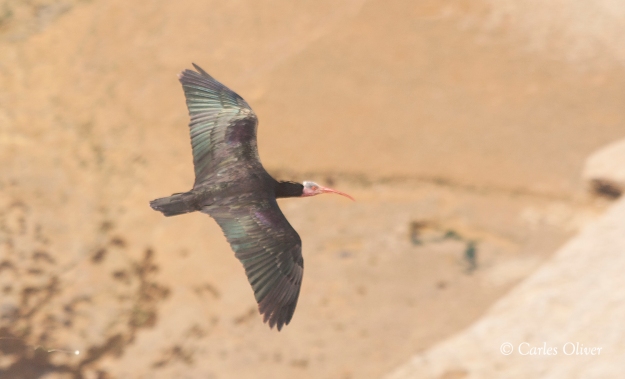
Northern Bald Ibis (Geronthicus eremita) is the most endangered ibis in the world and a must for anyone visiting Morocco. Image by tour leader Carles Oliver
We decided to wait a bit more and walk a bit beyond in the hope of having better views and our effort had a wonderful success since we soon got 4 Ibises flying close to us in a magnificient view! A small flock of 7 individuals also passed really close to us and we all got really good views right before 1 of them decided to stop less than 50 metres from us. Incredible views of the bird walking up the hill in the lush vegetation, looking for preys!!! We all enjoyed the birds and valorate the work of the people working there to manage and protect the colony of such as stunning bird!! After such a success we went for a bit of rest and lunch. It had been a good morning so far!
After lunch we went to a small quarry formerly hosting Peregrine Falcon (Falco peregrinus) but after some scanning we got no signal of any falcon at all. Instead, we got a flock of 15+ European Bee-eaters (Merops apiaster) overflying us!
Next stop in the trip was Cape Tamri. Here is a really good seawatching point and I’m always happy to invest some time here!! We enjoyed almost one hour of scanning in the Atlantic. We soon had several Atlantic Gannets (Morus bassanus) moving around, some of them quite close. Sandwich Tern (Sterna sandvicensis) were also spotted moving along the coastline, scanning for fish. I think the best birds were appearing some 10 minutes after our arrival… 4 Common Terns (Sterna hirundo) gave us relativelly close views as migrating North and immediatly after them we spotted 2 Great Shearwaters (Puffinus gravis) moving also North. Most of people in the group got these wonderful birds, but not everybody… Only a pair of minutes after that we all got 1 Great Skua (Stercorarius skua) flying up and diving in the sky while fiercely chasing Gannets! This was a great start but unfortunately we got nothing else as bird migration seemed low that day. Still, this is also a good place to see Euphorbies in detail, a group of plants having several endemic species in this part of Morocco and in the Canary Islands.
Still, before leaving we still added Pallid Swifts flying over us and we still added a pair of species when leaving: 3 Ruddy Turstones (Arenaria interpres) flew off from the rocks and Tomas had 1 Wimbrel (Numenius phaeopus). The transfer along the coast still produced some other good birds as Little Egret (Egretta garzetta) and Great White Egret (Casmerodius albus) were spotted in sea side. When being close to our accommodation, a final stop was made since a Little Owl (Athene noctua) sat by the road in the very last light of the day while Nightingales were singing in the dusk… After enjoying long views on the tiny owl, we just drove to our accommodation in the Souss-Massa National Park for an overnight.
Day 3. After a really good rest we started early that morning. Weather was quiet and sunny so we decided to do a pre-breakfast short walk (10 metres) around our accommodation that produced an excellent list of birds: House Buntings, Cirl Bunting (Emberiza cirlus), really obliging Moussier’s Redstarts, European Serins, Laughing Doves (Streptopelia senegalensis), Sardinian Warblers, European Bee-eaters flying over and Common Quails (Coturnix coturnix) singing in the fields around. We took a look the slopes around since Stone Curlews (Burhinus oedicnemus) are often around (and they were calling during the night) but we had no luck about.
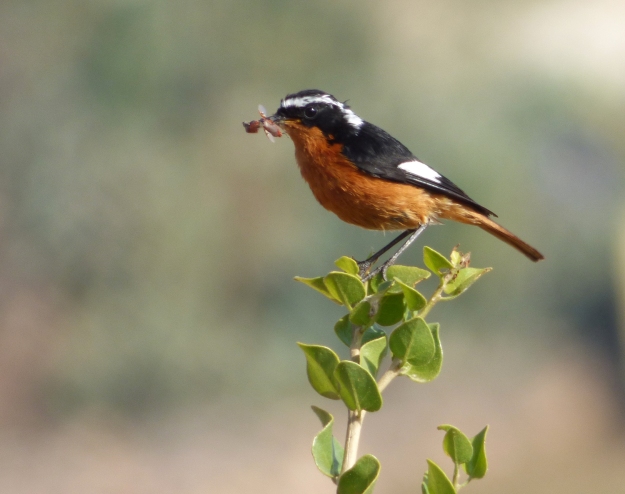
Moussier’s Redstart (Phoenicurus moussieri) is probably the most spectacular Maghreb endemic. Image by tour leader Carles Oliver
Main target was surprisingly easy to find since we had two Black-crowned Tchagras (Tchagra senegalus) singing immediately around our accommodation. A bit of scanning and some patience was needed to discover them but finally we all enjoy of long a good views on the birds singing in flight and also moving inside some small trees! Happy with this excellent start of the day we came back to our accommodation for some breakfast.
The very first stop of the trip produced again a good numbre of birds. Greenfinches, Sardinian Warblers, Moussier’s Redstarts, Black-eared Wheatears, Laughing Doves and Subalpine Warblers were all showing well. We stopped just by a small pool in the Souss River, a wonderful place for waterfowl and migratory passerines. Eurasian Coot (Fulica atra), Mallard (Anas platyrhynchos) and Moorhen (Gallinula chloropus) were added to our trip list. Little Egret was showing shortly but well and Grey Heron (Ardea cinerea) overflight us.
Inside the reeds we had good views on Eurasian Reed Warbler (Acrocephalus scirpaceus) and Sedge Warblers (Acrocephalus schoenobaenus) while calling not far from the water. At least 2 Tchagras were calling around but we could not have views on them… Here we got first views on Isabelline Warblers (Iduna opaca), also known as Western Olivaceous Warbler, moving in a small Tamarisks. Under it, a pair of Spanish Terrapins were peacefully having a sun bath. A short stop road onwards produced little out of some Eurasian Reed Warbler and 1 female Little Bittern (Ixobrychus minutus) showing quite well up in the reeds. A third stop was much more productive.
Even before parking we got Willow Warbler & Chiffchaff by the pond. Here a dense forest of small Tamarisk is found so it is a really good place to look for passerines. Soon we had excellent views on Isabelline Warblers along with Eurasian Reed Warblers. In the pool itself, a pair of Little Grebes (Tachybaptus ruficollis) were keen in territorial fights. Subalpine Warblers were also showing in the vegetation around just beside where a flock of 6 Black-crowned Night Herons (Nycticorax nycticorax) were roosting! We were really enjoying that small pond! Suddenly, a flock of 17 Glossy Ibises (Plegadis falcinellus) overflew us moving down the river and their irruption brought us to spot 2 European Kingfishers (Alcedo atthis) down the pool. A small walk was required to scan properly all the area. 1 Black-crowned Tchagra appear just under our feet to gave a second excellent view on such spectacular bush shrike! And then is when we start spotting Little Bitterns. If not wrong there were 4 of them! The most impressive, a male standing up out the reedbeds in full summer plomage. I think it was there for more than 20 minutes while another male was busy chasing females (2?) up and down the reedbeds… impressive for a normally secretive guys!!
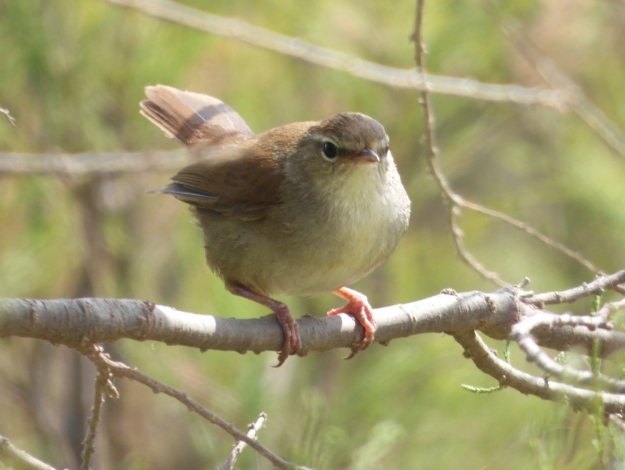
Cetti’s Warbler (Cettia cetti) is normally an obtrusive species living in riberside vegetation. Not that time. Image by tour leader Carles Oliver
Down the stream a Squacco Heron (Ardeolla ralloides) was also found and, in the fields around, the local form of European Stonechat (Saxicola rubicola), really more contrasted that average continental forms… Corn Bunting (Emberiza calandra), Zitting Cisticolas (Cisticola juncidis), European Goldfinches (Carduelis carduelis) and Crested Larks (Galerida cristata) gave also good views. But probably the best bird in this stop were the 4+ Brown-throated Sand Martins (Riparia paludicola) flying really close to us along with some Barn Swalows and (at least) 1 Sand Martin (Riparia riparia). It seemed that they nesting in the bank by the pool, something I never so before in that pool (I will take a second look in 2018, hopefully…). That was an excellent stop, and it was only 10:20 in the morning! We still explored another corner of the river. Here we got really close views on Spanish Terrapins along with amazing views on Cetti’s Warbler (Cettia cetti) singing 2 metres away from us! Iberian Yellow Wagtails (Motacilla flava iberiae) was also really obliging in this spot. Common Bulbul, Sedge Warbler, Reed Warbler and Moroccan Wagtails were also seen as well as Turtle Dove (Streptopelia turtur) singing from a dead tree. We scanned around for other birds but bird migration seemed to low so we got anything else than 2 Common Sandpipers (Actitis hypoleucos).
Back to our accommodation we enjoyed a really good lunch and, after some rest, we start going back to Marrakech. Still, we had a pair of hours to invest in the Massa estuary, always a wonderful place for birdwatching. The list of birds here was really long and included 1 Oystercatcher (Haematopus ostralegus), 200+ Common Ringed Plovers (Charadrius hiaticula), 100+ Kentish Plovers (Charadrius alexandrinus), 20+ Dunlins (Calidris alpina), 20+ Sanderlings (Calidris alba), 7+ Knots (Calidris canutus), 12+ Ruff (Philomacus pugnax), Common Redshanks (Tringa totanus), Greenshanks (Tringa nebularia), 20+ Bar-tailed Godwits (Limosa lapponica), 1 Black-tailed Godwit (Limosa limosa), 10+ Little Stints (Calidris minuta), +5 Eurasian Curlews (Numenius arquata), 15+ Grey Plovers (Pluvialis squatarola), Common Sandpipers, Ruddy Turnstones and lovely views on the several Pied Avocets (Recurvirostra avosetta) and Black-winged Stilts (Himantopus himantopus) along the mud flats.
A careful scanning on the flocks of gulls roosting along the river mouth produced Yellow-legged Gulls, Lesser Black-backed Gulls, Black-headed Gull (Chroicocephalus ridibundus) and 5+ Mediterranean Gulls (Larus melanocephalus), all of them 2nd years. But the most celebrated gulls were 3 Slender-billed Gulls (Chroicocephalus genei) all of them adults, that were showing the beautiful pinkish buff in their breasts… Several terns were also sleeping, many times mixed along with gulls. Almost 100 Gull-billed Terns (Gelochelidon nilotica) we counted and some Sandwich Terns (Sterna sandvicensis) were also seen, allowing good comparision in structure and size between both species. Beyond the estuary we still had a flock of 25+ Greater Flamingoes (Phoenicopterus ruber) as well as good numbers of Grey Heron, Little Egret and Great White Egret. 60+ White Storks were also roosting in the mud flats… Some Great Cormorants (Phalacrocorax carbo) were roosting as well in the mud and we were all happy to find a Moroccan Cormorant (Phalacrocorax carbo morocannus) among them! This is a really scarce race (and a good candidate for a future split…) All of this while one confiding Osprey was eating a fish in a post. After enjoying this amazing spot we drave back to Marrakech to enjoy a good dinner and a better sleep!

Moroccan Magpie (Pica pica mauretanica), a beautiful race likely yoel be recognised as full species in short time. Image by tour leader Carles Oliver
Day 4. This day we crossed the Atlas North to South, enjoying a good variety of landscapes and some of most unforgettable views you can get in this mountain chain. But before going really up we still had a pair of morning stops. First stop along one gorge East of Marrakech. Here we enjoyed some birds along the road including Black-eared Wheatears, Thekla Larks, Crested Larks and Black Wheatears.
We soon did a stop at the top of some cliffs. 1 male Blue Rock Thrush was on a pylon by the van so it was a good start. Two pairs of Common Kestrels were having an argument in the sky but fast our attention was concentrated on a wonderful Lanner Falcon (Falco biarmicus) sitting on the top the cliff! We got stunning views on the bird while preening and overlooking the valley around. After everybody could enjoy the bird we started to scan the river and the valley beyond. We invested about 30 minutes and during the whole time the Lanner Falcon stayed at its place, providing us with good views from differents angles. The scanning of the river soon prodided with up to 7 Ruddy Shelducks (Tadorna ferruginea) that were really wellcome in the group. Brown-throated Sand Martins were also flying along the stream along with at least 1 Western House Martin (Delichon urbicum) and some Crag Martins (Prynoprogne rupestris).
A carefully scanning of the small muddy areas produced 3+ Little Ringed Plovers (Charadrius dubius) & 3 Green Sandpipers (Tringa ochropus). Up in the sky, a flock of 30+ Black Kites (Milvus migrans) suddenly appeared, circling, but they soon kept going North, following their migratory route. We short stop beyond this point still produced anothe good bird, since 15+ Spanish Sparrows (Passer hispanoliensis) were spotted in a small field by some houses. Here we also had House Sparrows, Sardinian Warblers, Woodchat Shrike, Common Bulbuls and close views on 1 Zitting Cisticola. In the wires there were also 2 Common Rock Sparrows, but I think I was the only one to have them, the group was concentrated in enjoying the Spanish ones…
Back to the main road up the Atlas we still had a number of stops in the Southern slope. The lowest one produced typical views on Thekla Lark, European Stonechat, Zitting Cisticola, Woodchat Shrike and Sardinian Warbler but also wonderful views on 1 Barbary Partridge in the middle of one field. This corner is having huge density of them and don’t really know any other place in Morocco where finding this bird is so easy! Here we also had the firsts 2 White Wagtails (Motacilla alba) of the trip and 2 extremely close Little Ringed Plovers. The very last bird before living the area was a wonderful Booted Eagle (Aquila pennata), ligth form, really low over the olive orchads…
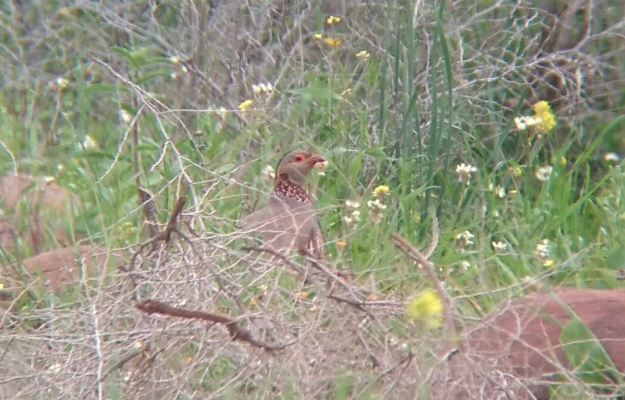
Barbary Partridge (Alectoris barbara) can be surprisingly difficult to spot. This year we got excellent views, again! Image by tour leader Carles Oliver
Some more stops along the road were done as raptors were spotted. 4 Booted Eagles, 2 Eurasian Sparrowhawks (Accipiter nisus) and 1 Short-toed Eagle were all seen along the road. Once in the highest area of the road (above 2000 metres!) we still had a pair of stops to admire the landscapes around. Common Raven were around and we were surprised by 1 Peregrine Falcon (Falco peregrinus brookei) flying around us, quite close! At 2200 metres we still had a new stop since 1 male Montagu’s Harrier (Circus pygargus) was spotted just by the car! We enjoyed good views on the bird while flying against the strong wind!!! In the slopes above, a flock of Alpine Choughs was also a good bird appearing!
Once in the Southern slope the temperature started to go up fast, but it was really, really windy. Despite the really strong wind we decided to explore a small valley before going to our accommodation in Ouarzazate. Here we were looking for Maghreb Wheatear (Oenanthe halophila), one of the most difficult birds in Morocco. After more than 90 minutes of scanning we decided to quit and go to rest after a good day. No signal of this Wheatear. Still, we had firsts views on Desert Lark (Ammomanes deserti), White-crowned Black Wheatear (Oenanthe leucopyga), both lifers for everyone in the group, plus good views on Black-eared Wheatear, Northern Wheatear and Moussier’s Redstart.
Day 5. Early morning start. After the difficulties of the last afternoon because of the wind, that morning we were all hoped for a calm day. Weather conditions were much better and after breakfast we confirmed that it was no wind at all. Happy for that we decided to have a second look to the same location we were the afternoon before. Unfortunately this place produced no Maghreb Wheatear since we only had exactly the same species than we had the afternoon before…
Still, a short exploration of some orchads around produced really good birds including 4+ Hoopoes (Upupa epops), +5 Common Redstarts (Phoenicurus phoenicurus), several Subalpine Warblers and 5+ Western Bonelli’s Warblers (Phylloscopus bonelli). The site also produced lovely views on Maghreb Larks (Galerida macrorrhyncha) and we even got some good views on Thekla and Maghreb Larks side by side, a good way to see how different do they are! As “always”, Woodchat Shrikes were also around. A second stop by the road was made to check for Maghreb Wheatear with no signal of any bird… still, we had even more Western Bonelli’s & Subalpine Warblers plus Chiffchaff and 100+ Black Kites (Milvus migrans) that were moving North!! It was a beautiful view to see them flying quite low and everybody enjoy to see them fighting against the wind (it was still windy high up). As there were some raptors all the time around we did a further stop to check around for something different and we got our only 1 Marsh Harrier (Circus aeruginosus) of the trip, and more Black Kites!
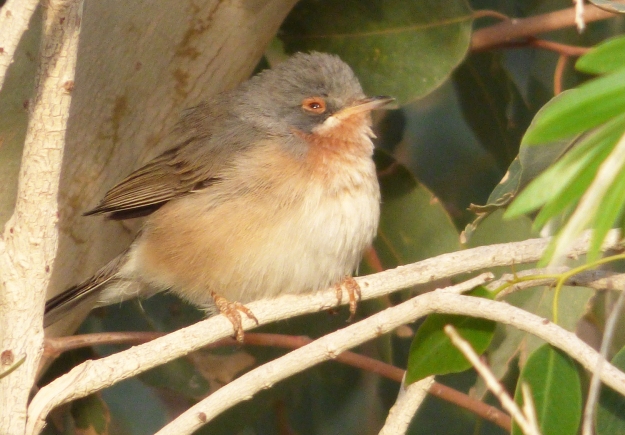
Western Subalpine Warblers (Sylvia cantillans) can be really common during some weeks in early spring. Image by tour leader Carles Oliver
When coming back to Ouarzazate (not even 10:00am), Tomas spotted a flock of small birds by the road so stop to take a look. After some scanning we found that there were 40+ Greater Short-toed Larks (Calandrella brachydactyla). We got nice views on them! Even inside the city we also had a stop since a field was flooded really close of the road… a good excuse to stop and check. This field was full of Yellow Wagtails (Motacilla flava sps) and some check showed us some Iberian Yellow Wagtails (Motacilla flava iberiae), 1 Scandinavian Yellow Wagtail (Motacilla flava thunbergi) and nominal Grey-headed Wagtails (Motacilla flava flava). Here we also had good views on at least 1 surprising Water Pipit (Anthus spinolleta) and 3+ Meadow Pipits (Anthus pratensis). Green Sanpiper & Little Ringed Plovers were also present here while flocks of swallows and European Bee-eaters were seen around. Here I had one pipit showing some whitish stripes in the back and plane face… still, anybody can had good views in this bird… unfortunately!
After this stop our next stop was the big dump immediatly South & East of Ouarzazate. A short transfer was necessary to arrive to one of the best places for birding in the dump. Here we soon had good views on Kentish Plovers (really common this time), Black-winged Stilts, Northern Shovelers (Anas clypeata), Ruddy Shelducks, Grey Herons, Greenshanks, Little Stints, Great Crested Grebes (Podiceps cristatus), Common Ringed Plovers and Redshanks. Good birds included 5 Curlew Sandpipers (Calidris ferruginea), 2 Spotted Redshanks (Tringa erythropus) and a good flock of 20+ Pied Avocets (Recurvirostra avosetta) spotted by Frumie. Special mention to 4 Collared Pratincoles (Glareola pratincola) roosting in a small mud flat, good spot by Tomas, 1 juvenile Short-toed Eagle, 2 Montagu’s Harriers females (1 of them a superb melanic form) and, after a funny short walk, hundreds of Red-knobbed Coots (Fulica cristata) feeding, preening and fighting in the water along with Ruddy Shelducks! The dump provided also with good views on Isabelline Warbler, Pallid Swifts, Iberian Yellow Wagtail & Maghreb Larks.
After lunch we did our transfer to Boumalne du Dades and, after check-in in our accommodation we spent the afternoon in the famous Taghdild Road. Even before arriving we just did a first small stop since a flock of Greenfinches were feeding by the road when suddenly, a gorgeous Barbary Falcon (Falco peregrinoides) appeared from the sky in a very agressive dive close to the finches. We all jumped out the van and could have really good views on the fast flying, small sized, falcon. Really pointed wings and size and structure a bit resembling to Merlin (Falco columbarius). That was a brilliant start to our afternoon!!
Once in the place several stops were made and we had really lovely views on both Desert (Oenanthe deserti) & Red-rumped Wheatears (Oenanthe moesta) as well as Thekla Larks, Lesser Short-toed Larks (Calandrella rufescens), Greater Short-toed Larks. Special mention to our firsts Temminck’s Horned Larks (Eremophila bilopha) of trip! This lark still ranks as my favourite lark… what a lovely bird! The afternoon was being good and we add 1 female Black-eared Wheatear to our day list plus some Northern Wheatears and White Wagtails. By the rubbish dump we also had a small flock of 4+ Trumpeter Finches (Bucanetes githagineus) but most of the group only had poor views on the birds. There were simply too much inputs around so the people was dispersed!! 2 Long-legged Buzzards were showing well around… We kept moving in the steppes, the endless, ondulate steppe all for us! I just love this place… After some kilometres (2, 5, 10?) we just had 2 Black-bellied Sandgrouses (Pterocles orientalis) flying around us. We had good views on them! Kept moving on and we flew 2 more, quite close! Time to check around… Soon we had really good views on a pair of Black-bellieds moving in the steppe some 50 metres in front of us. We enjoy them really a lot, with a lovely afternoon light! They even decided to cross the road and the male had a sand bath right in front of us!!
A further scan soon produced the top bird of the day, since Tomas spotted a flock of 8+ Cream-coloured Coursers (Cursorius cursor) moving at our right. Once out of the van we got lovely views on the birds in the scopes… doing their small runs while looking for beetles, their favourite prey! Along with them, a pair of wonderful Hoopoe Larks (Alaemon alaudipes) were really showy and, despite they were not really close, we all enjoy their exhibition flights while singing! That had been a wonderful end for a not really bad day! We came to our hotel to have a good dinner and a chat about all the birds we had enjoyed that day!
Day 6. We started the day with bad news on weather. The afternoon before we had quite a lot of cold wind and since it didn’t stop during the night we were facing a cold, windy morning… difficult conditions to spot the birds we needed. Still, we went down the plains full of energy and soon we started having good birds. 3 Long-legged Buzzards gave us really good views as did Red-rumped Wheatears, Temminck’s Horned Lark, Thekla Lark, several Greater Short-toed Larks moving aroung and Little Ringed Plovers, White Wagtails, Iberian Yellow Wagtails and Meadow Pipits! We decided to stop and scan in a place that look like particularly good and we fastly got 2 Stone Curlews (Burhinus oedicnemus) roosting on the ground! It was a lovely view… a further scanning produced really good views on 2 Tawny Pipits (Anthus campestris), a species which is normally not appearing in this trip!! Despite the really good sights wind was still really strong so we decided to come back to the van and scan while driving slowy, expecting for something more…
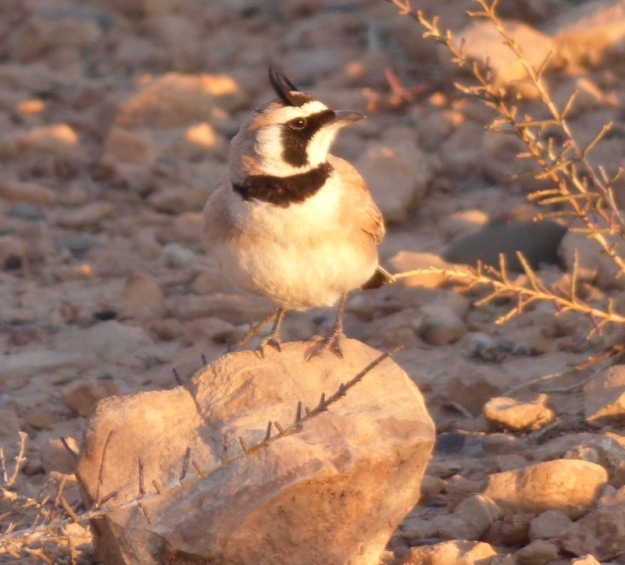
Temminck’s Lark (Eremolauda billopha), a small lark living in highland steppe plateaus. Image by tour leader Carles Oliver
It took some kilometres until Adrianne was having a bird in the road…. 1 male Thick-billed Lark (Rhamphocoris clotbei)!! The bird flew off, but didn’t go far so we came out and walk around, scanning. Unfortunately we could not have it again… We kept driving around and scanning until we got some Thick-billed Larks flying around! They were stopping not far from us so we stopped and jumped out the van… and well, this time we had really good views on a 3+ Thick-billed Larks moving on the ground! This bird was really celebrated by the group, also because it became the easiest lark to identified!! Thick-billed Larks can be quite difficult to spot since their numbers are highly variable depending on the year (normally really low) and become highly nomadic birds when out of the nesting season… Happy after this spot we decided to try a different location.
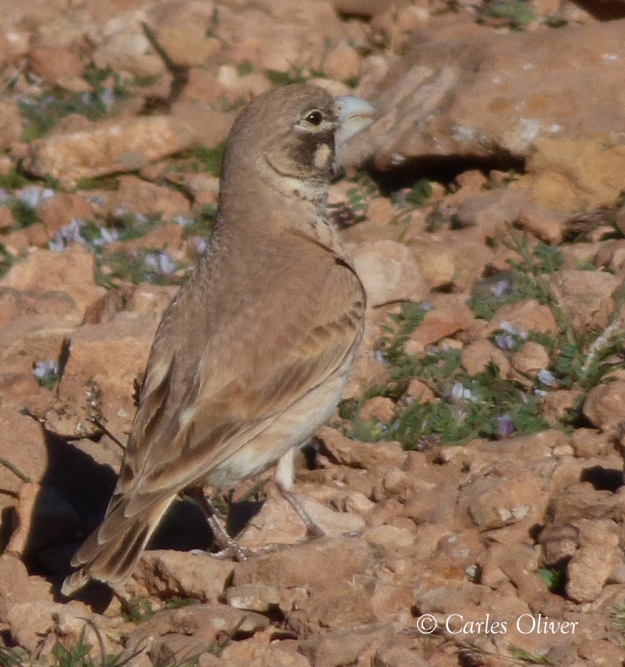
Thick-billed Lark (Rhamphocoris clotbei) is a highly nomadic bird out of nesting season. Image by tour leader Carles Oliver
A stream beyond the area is normally having water and it is a good place for migratory birds. A really unknown pond not far from there is a really good place as it attracks Sandgrouses in dry years. We checked all places but none of them were having water at all. The place was quite poor in birds this year. Still, we had good views on House Bunting, Woodchat Shrike, Isabelline Warbler, Maghreb Lark and W Bonelli’s Warbler.
Next stop was to explore a small gorge close to Boumalne. We left the van for a short walk, sheltered from the wind. The place was really productive since we had really good views on Desert Larks, 4 Black-eared Wheatears, European Serins, House Buntings and one pair of lovely Trumpeter Finches that were showing really well while feeding on the ground. We just stopped by a view point to scan the gorge and we soon we enjoying excellent views on 1 roosting Pharaon Eagle Owl (Bubo ascalaphus) by its whole!!! What a stunning bird! We spent some 20 minutes enjoying the owl and the finches, the owl calling a pair of times to remind us he was the Sir of that land..
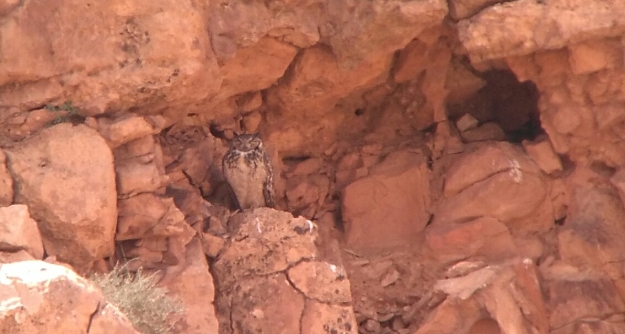
Pharaon Eagle Owl (Bubo ascalaphus) delighted us with walk-away views, and some action! Phonoscoped by Carles Oliver
After such a successful start we just went to the famous Gorge du Dades to have some lunch. Still, in the way up we had to do a fast stop since a Short-toed Eagle was cicling in the sky. The bird was fastly dissapearing behind the mountains but it was replaced in the sky by a superb Bonelli’s Eagle (Aquila fasciata)! The bird was in fact chasing the Short-toed!!! We didn’t see the fight properly since it happened out of our view but we had the Bonelli’s going up and diving to where the Short-toed was flying. This first Bonelli’s was soon joined by its pair and then we had excellent views of both birds circling in the sky… impressive! Happy after such a wonderful sight we finally got to the restaurant and enjoyed some rest…
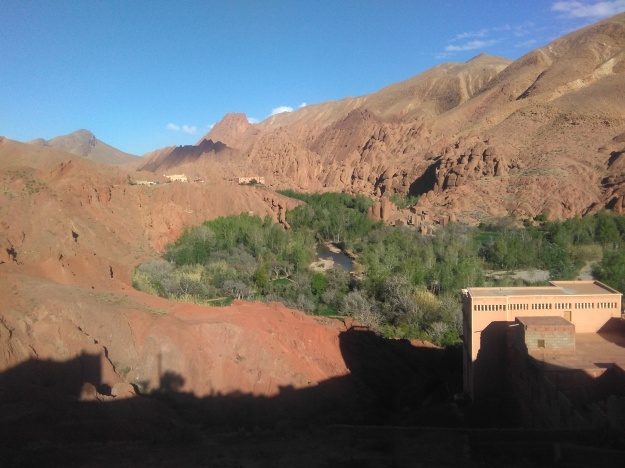
Dades Gorges, combines geat birding with ashtonishing scenery. Image by tour leader Carles Oliver
We had a lovely lunch enjoying the sun that was fastly warming up the air. Several Crag Martins were flying around us. African Chaffinch, African Blue Tit & Grey Wagtail (Motacilla cinerea) showed well in the Dades River. 1 Wren (Troglodytes troglodytes) was singing at the other side of the river but, despite our efforts, none of us could see the bird so it could not be add to the trip list. After lunch we did a pair of stops looking for Rock Buntings (Emberiza cia) but we only got a distant bird calling in the gorge… still, we enjoyed good views on Blue Rock Thrushes, Black Wheatears, Sardinian Warblers, Common Kestrel, Crag Martins and 40+ Red-billed Choughs…
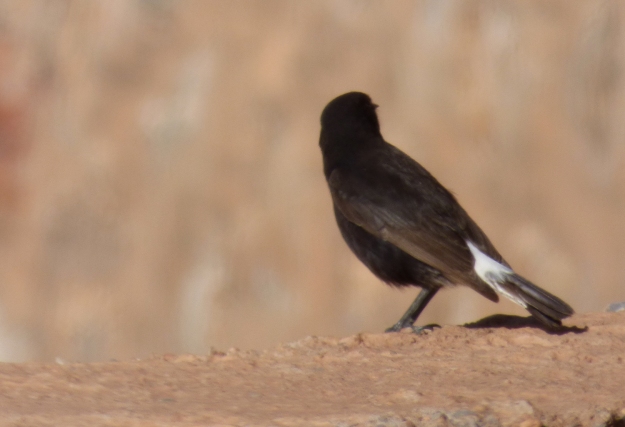
Black Wheatear (Oenanthe leucura) is having in Atlas mountains its Southernmost population. Image by tour leader Carles Oliver
A further stop was made in a cliff and we were soon enjoying a Barbary Falcon quite close in the very top of the cliff. It was a really good view and I was personally surprised on how fast we found the bird!! Still, this species is having a pair of territories around Boumalne so it is a really good place for them! The very last stop of the afternoon was to explore some orchads that can host a good variety of migratory birds. Here we had W Bonelli’s Warbler and we were surprised by really close and long views on 1 Melodious Warbler (Hippolais polyglotta) and 4+ Common Whitethroats (Sylvia communis). A singing Nightingale (Luscinia megarhynchos) focused our attention and, after a long scanning, we finally managed to find the bird singing from a quite high perch! This view was also quite appreciated in the group. Here we also heard Cetti’s Warbler singing & Great Spotted Woodpecker drumming. After such a successful afternoon we came back to our hotel to enjoy some Moroccan tea and dinner!
Day 7. This day started with a clear rise on the temperatures. After some windy and chilly days we finally left the hotel in a sunny, calm, warm day! During that day we were driving South towards the desert… to meet the Sahara!
In our way South we had some stops, anyway. Our first stop was to explore some proper habitat for Maghreb Wheatear (Oenanthe halophila). A pair of days ago we failed to find any of them so we were all hoping for better luck this time. Once we left the car we had some good birds moving around: House Bunting, a small flock of Trumpeter Finches, Desert Wheatear and 1 female Moussier’s Redstart. We decided to do a small walk, exploring some slopes beyond the road. After few minutes we arrived to a proper place to scan different rocky slopes around. There we had good views on Red-rumped Wheatears, Desert Wheatears, Northern Wheatear, White-crowned Black Wheatear and Desert Larks.

Maghreb Wheatear (Oenanthe halophila) is a scarce bird with a very limited range. Image by tour leader Carles Oliver
Suddenly, a Wheatear came to us extremely close… it was so close that we had difficulties in recognise that it actually was a female Maghreb Wheatear! We followed the bird in the slope but it was disappearing really fast! After less than one minute a gorgeous male was also appearing about 15 metres from the group. Then we all had excellent views on the bird. After having a small insect in the poor vegetated plain it flew up to the ondulated terrain. We walked some metres to keep the track of the bird and we again had excellent views on the this craking bird for almost one minute. After that it flew off, going beyond the small hills around… After such a wonderful views we “all came back really happy to the mini bus. In our way back we still had time to pick up a plentiful Spectacled Warbler male and a Booted Eagle soaring over the mini-bus.
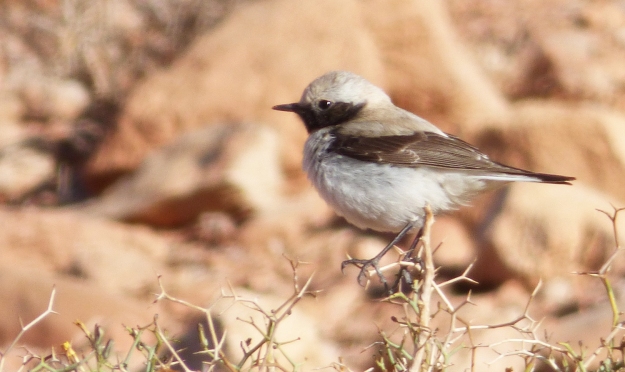
Maghreb Wheatear (Oenanthe halophila) in black-throated form was showing that well for some time. Image by tour leader Carles Oliver
A final stop was done in our way to the Sahara, this time to explore a place for Scrub Warbler (Scotocerca inquieta). Despite our efforts we could not locate any of them, this time. Instead, we got wonderful views on a pair of Bar-tailed Lark (Ammomanes cinctura) moving in the really open landscape they favour. Our walk along a pair of dry river beds produced also good views on Desert Grey Shrike (Lanius elegans), 3 Woodchat Shrikes, Spectacled Warblers and a good flock of 15+ Greater Short-toed Larks feeding few metres from us.
After this good stop we just went for a rather frugal lunch and drove to our accommodation in the desert, where we could enjoy of some rest and a wonderful sunset in the dunes…
Day 8. Everything ready for our day in the desert. Our local guide punctually came to our accommodation in Merzouga and we started our trip while listening the “tac-tac” calls of the Subalpine Warblers all around the gardens of our hotel. In our aim to find them we had also good looks on some Willow Warblers.
Our first stop that morning was to check a small water pond where Sandgrouses are coming to drink water. Sandgrouses need to drink water almost daily, especially during the nesting season, when they bring water to the chicks using an extremelly especialized feathers in the breast. The severe drought during the winter had left very few water sources left in this part of Morocco so we were expecting to have some flocks moving around.
Even before arriving to the pond we had our first flock of Spotted Sandgrouses (Pterocles senegallus) lying on the stony desert. We had really good views on the birds and we enjoyed taking some photos. Once placed near the pond we had time to scan the large plain around. Soon we spotted several flocks of Sandgrouses, including both Spotted & Crowned Sandgrouses (Pterocles coronata). A Barbary Falcon appeared in a incredible dive in a good trial to pick one of the several Sandgrouses around…

Spotted Sandgrouse (Pterocles senegallus) female posing for us in the desert. Image by tour leader Carles Oliver
After 10 minutes of waiting, finally one flock of Crowned Sandgrouses came to the pond. They landed some metres away from the water preening and walking slowly while waiting for the proper moment to drink water. And suddenly the momment arrived. In few seconds tens of Sandgrouses flew to the pond from all around the plain. In few seconds we were surrounded by small flocks of them, all flying around and coming in fast approaches to the water!
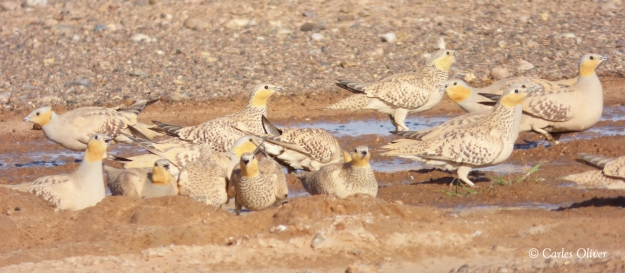
Flock of Sandgrouses drinking water in the desert. Image by tour leader Carles Oliver
The sound of these hords of Sandgrouses landing and taking off from the pond in different waves is ranking high in my birding memories and something that all participants in the trip will remember for ever!!
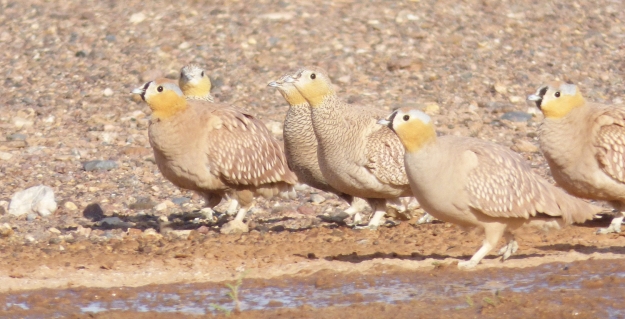
Crowned Sandgrouses (Pterocles coronata) is often a scarce species living in semi-arid countryside. Image by tour leader Carles Oliver
After several counts we concluded that a minimum of 48 Crowned and 120+ Spotted Sandgrouses were around us!!!
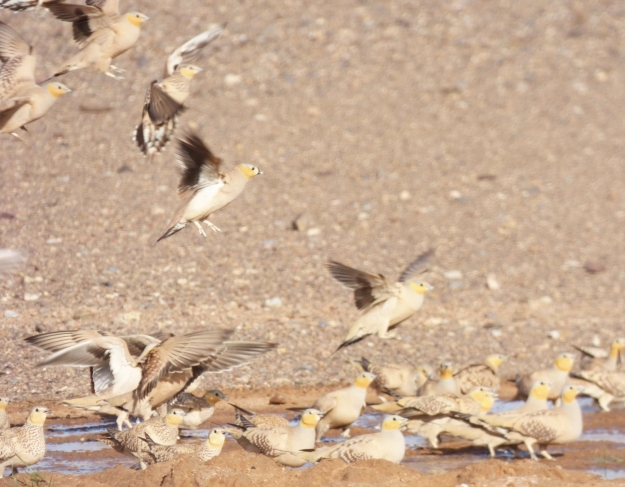
Mixed flock of Sandgrouses coming to drink water in a tiny pond in Merzouga. Image by tour leader Carles Oliver
After enjoying as long as necessary of such a magic momment we moved to explore a nearby oases. Here we soon enjoyed some good birds such as Woodchat Shrike, Common Redstart, Subalpine Warbler and Melodious Warbler while some flocks of European Bee-eaters were moving around. A short scanning around let us locate a wonderful male Desert Sparrow (Passer simplex), our main target in that location! We had a male and one female in walk-away views while preening, feeding along House Sparrows and calling all around. What a beauty!
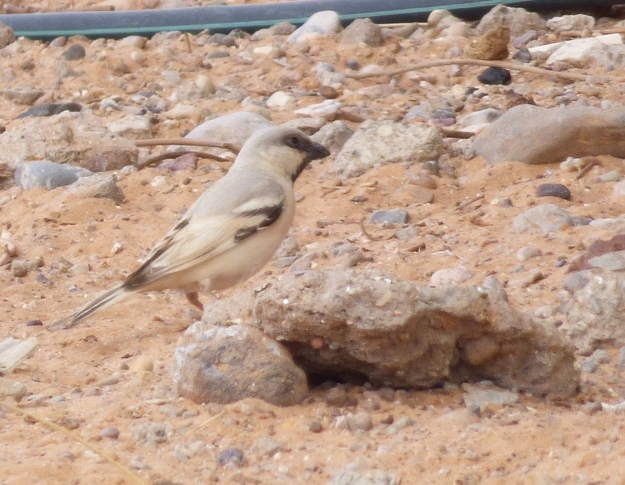
Back to the desert we spent some time in a wadi with some sparse vegetation. Here we were soon enjoying 2 Hoopoe Larks (Alaemon alaudipes) moving in the desert, singing and offering good views in a short display. Brown-necked Ravens (Corvus ruficollis) were flying around and we had our first views on these desert birds. A few metres after we spotted a wonderful African Desert Warbler (Sylvia deserti), a bird that can be quite difficult to locate! In a pair of minutes we were all enjoying of really, really close up views on the bird and photographers in the group were really happy about such a close views!!

The morning was great so far. Our next stop was really deep in the desert where we met our special guide to help us locate the scarce Egyptian Nightjar (Caprimulgus aegyptiacus). Soon, we were amazed about the skills of that nomad, a silent and pleasant old man, that fastly located not one, neither two, but three nightjars roosting in the wadi…
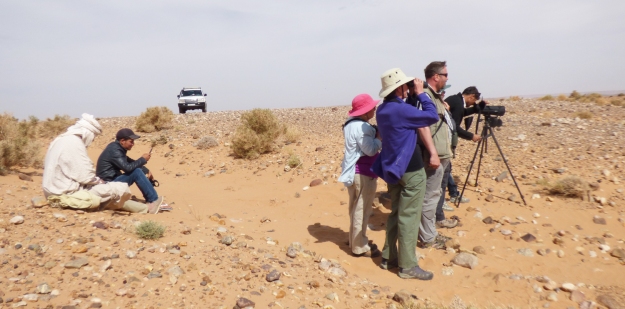
Our group enjoying some birding in the desert. Image by tour leader Carles Oliver
We could enjoy incredible views on them in the scopes and had a hard but wonderful time until all members in the group could find the birds with their our bins… Everybody enjoyed to see how such a big birds can be so hard to spot while roosting directly on the ground, out of any vegetation! Because of that, this was the bird of the trip for many of the participants in the trip.
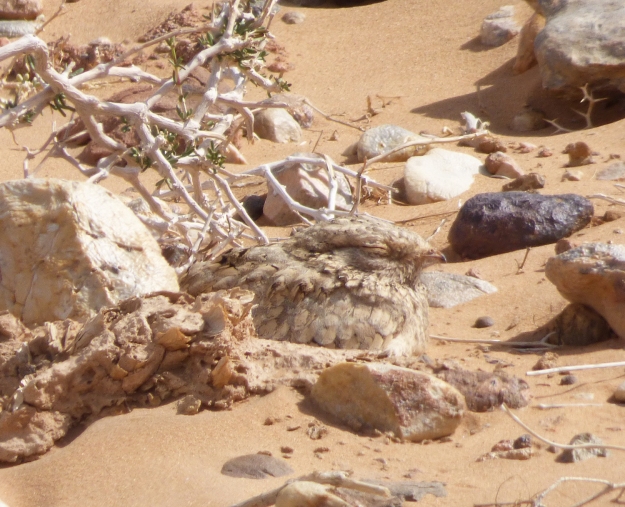
After such a successful morning we went for a good lunch and some rest. After our rest we went for a short exploration of some oases around Rissani, where we had excellent views on Maghreb Larks and the firsts Blue-cheeked Bee-eaters (Merops persicus) of the trip. Superb birds that we could enjoy while catching insects in flight around us! Other birds here include also Blackbird and Laughing Dove. Some scanning was required to have the main target of the stop, thought. Despite the strong sun, we had a Fulvous Babbler (Turdoides fulva) sitting low in a palm tree. We fastly all moved to the bird, trying to cut some of the three hundred metres from it and us… After a small running we had good views on the bird, now joined by a second individual, that were flying around us!!! Happy all with the good views on this difficult species we decided to invest some time in a final stop.

One of the three Egyptian Nightjars we had during our trip! Image by tour leader Carles Oliver
Our last stop that day was to look for the very scarce and difficult to spot Scrub Warbler. A first walk around the area alowed us to have our only 1 Seebohm’s Wheatear (Oenanthe seebohmii) of the trip, that was really celebrated in the group. Hoopoe Larks were also around there. We had a walk along the wadi, trying to cover as much area as possible to try to have this elusive bird. After more than 40 minutes, we were all about to quit when Tomas had something moving low in the vegetation very close to us… I saw it for 1 second but it was a Scrub Warbler!!!
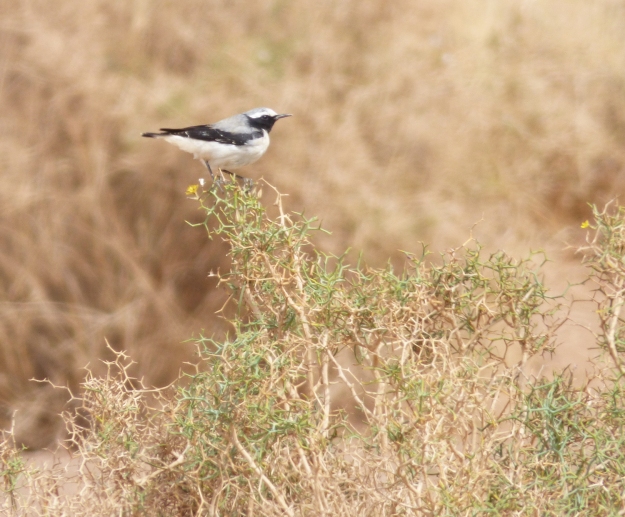
Seehbom’s Wheatear (Oenanthe seehbomi) is nesting in high mountain grasslands. Image by tour leader Carles Oliver
Everybody jumped off the mini bus and started scanning the bush immediatly around, but nothing. We spent an extra 20 minutes scanning all around we were uncapable to relocate the bird that looked like being into the sand… A pitty, because only me and one participant could have a really short view on the bird…
Still, the day had been amazing and we all came back for some rest and wonderful dinner in our accommodation!
Day 9. This was our very last day of “birding” of the trip, since the last day was, as usual, basically driving but with a really good surprise in the morning… After breakfast we drove a short distance until one nearby hotel, having really extensive gardens and orchads which are really good for migratory passerines.
The day before had been windy so the sensation when we arrived was quiet. Still, after a short walk, we started to have some good birds. 3 Common Redstarts were spotted in the orchads followed by several Western Bonelli’s Warblers and Subalpine Warblers. Up in one tree it was also a Garden Warbler (Sylvia borin) but I was the only one in having this bird… A carefully scanning produced Willow Warblers and 1 Chiffchaff. Soon our attention was demanded in a medium size bird skulking low in the grass and, after a bit of waiting, we soon were all enjoying of really close views on a group of three Fulvous Babblers! It was phantastic to see them that close as they were looking for food in the rather tall grass while doing really soft contact calls… that was really improving the views we had on this bird the day before!
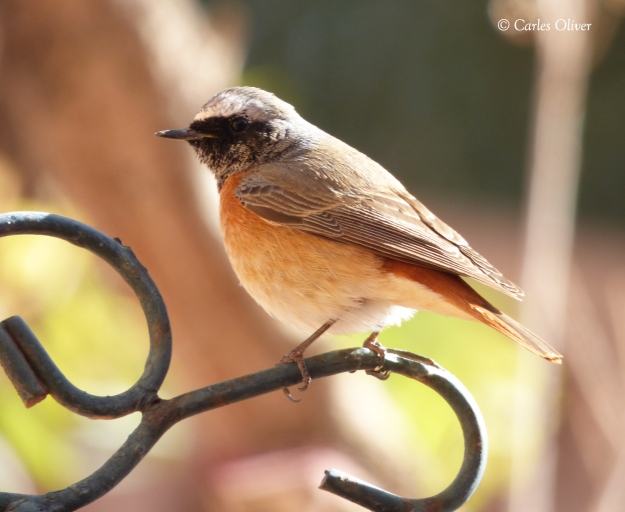
Common Redstart (Phoenicurus phoenicurus), a common bird in migration in Morocco. Image by tour leader Carles Oliver
We enjoyed the Babblers long while keep scanning for other birds. White-crowned Black Wheatears were all around as it was a wonderful flock of European Bee-eaters. Here we also had Blackbird, Laughing Dove, European Robin and Sardinian Warbler. It was starting to be windy again so we looked for shelter around the walls of the hotel as some birds did since here we had really close views on one male Common Redstart, Woodchat Shrike and 1 wonderful Western Orphean Warbler (Sylvia hortensis) that was posing for us for more than 5 minutes!!! Great found!!
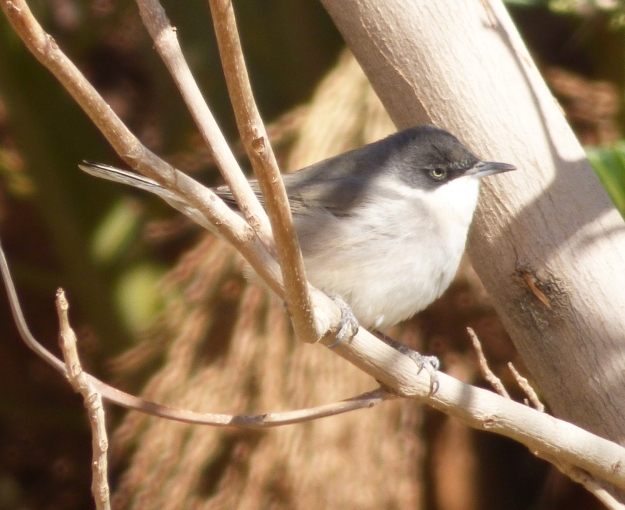
Western Orphean Warbler (Sylvia hortensis) is normally really obtrusive but this year we had walk-away views in the open. Image by tour leader Carles Oliver
Once outside the hotel, we did a final round to try to have something else. In this second walk we had good views on Western Olivaceous Warbler (also known as Isabelline Warbler) and a second W Orphean Warbler but not so much else. Right before leaving Tomas spotted a Pied Flycatcher (Ficedula hypoleuca) in the tamarisk around. We all enjoyed good views on the only one “real” flycatcher we had in the trip!

As was already quite windy we decided to change location and try a small stream running in the desert, expecting to have some more migratory birds while being sheltered from the wind. Once we arrived we realised we were sheltered from the wind but the reedbeds were not so it was going to be challenging to find anything down there. Still, we did a walk, and it was great!
Here we enjoyed of really close views on Blue-cheeked Bee-eaters flying around us and catching insects all around! A short walk along the reeds soon produced Eurasian Coot, a pair of Eurasian Reed Warblers singing and Iberian Yellow Wagtails in the move around. Woodchat & Desert Grey Shrikes were seen around. 1 Little Egret was fishing down the river and Sand Martins were seen in small flocks all along the river bed. But the very best bird in this spot was a wonderful pair of Marbled Ducks (Marmaronetta angustirostris) that were flushed from the river and gave us excellent views while flying around!!
This is a really scarce and endangered bird with some good populations in Morocco and South Spain. Due to the drought I was not really expecting to find any so this was a wonderful bonus for the trip! These ducks were really celebrated by the group. We kept scanning but the wind was not really helpful so we decided to go to Rissani for an early lunch.
After lunch we went to a small tamarisk forest expecting to have good views in more migratory and some good specialities… Here we found tones of Western Bonelli’s Warblers that were all around us along with Subalpine Warblers… A pair of Moroccan Wagtails flought along and we had really good views in a nearby pond. There we also had some Black-winged Stilts, 3 Little Ringed Plover, Moorhen and Laughing Dove. A mixed flock of both European & Blue-chekeed Bee-eaters gave us a good comparition of both species and a Turtle Dove was singing from a wire, giving also good views.
Back to tall tamarisk we kept looking for the main target of this stop, to have good views on Saharan Olivaceous Warbler (Iduna pallida reiseri), a race that is considered for some as a different species. Difficult to tell apart from Western Olivaceous Warbler is smaller, less heavy-billed a rather more rounded-headed that Western Olivaceous.
So, we invest quite a lot of time trying to have good views. We had at least two males singing quite close inside the tamarisk but, despite our efforts, we could not have more than glimpses of half-a-secong to one second in the birds… The wind and about 10 Western Bonelli’s Warblers in the same bush were not really helpful… After some long “fight” we finally decided to quit, more or less satisfied with these rather poor views.
After arriving to our lodge, some members in the group decided to stay in the accommodation for a walk in the dunes and those who want to join were coming for a final walk in our first location. In this 30 minutes visit we didn’t add anything different from our morning visit but had really good views again in Western Orphean Warbler, Isabellines Warbler and Fulvous Babbler…
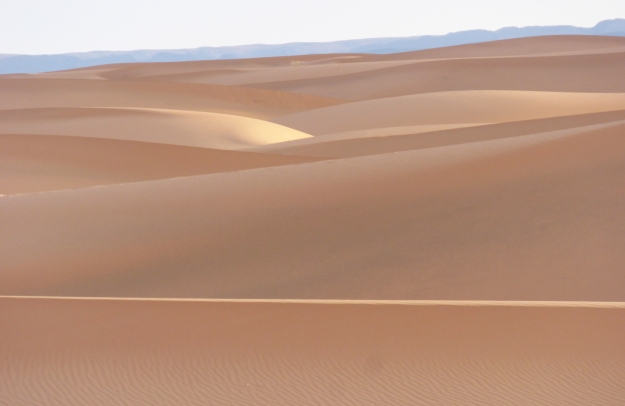
Dunes textures in Merzouga. A wonderful experience. Image by tour leader Carles Oliver
Day 10. Very last day of the trip and final transfer to Marrakech. But before we still had to do some duty. We came to one of spots were we first were looking for Scrub Warbler as not everybody in the group was enjoying this bird. We didn’t have a lot of time to invest so we had a walk along the wadi, expecting to have any signal of bird activity out of the Hoopoe Larks displaying around and the beautiful Desert Wheatears.
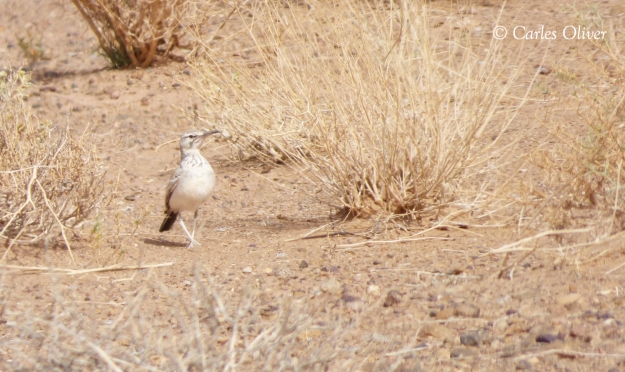
Greater Hoopoe Lark (Alaemon alaudipes) is probably the most spectacular lark living in Morocco. Image by tour leader Carles Oliver
We did a long walk, carefully scanning all bush around and listening for any small call coming from anywhere around us but, after half an hour we got nothing. Well, I stopped there, thinking about going back for the car and the many birds we had enjoyed when, suddenly, a extremely low call came to my ears. I looked to my left and I saw a small movement inside one bush and, before my brain could react, a wonderful Scrub Warbler was appearing on the ground, 3 metres from me!
I shout everybody to come (all of them dispersed in the wadi). Some running was happening and soon everybody was close. The bird was still around, skulking and moving. Some seconds of waiting and then we all had excellent views on the bird, that was appearing on the ground for a couple of second before coming back inside the bush. The bird was moving bush by bush, in a bush-ground-bush sequence that gave us really good views and probably the worst ever shots on this species… Excellent! Everybody in the group had enjoyed almost one minute of the movements of such a tricky bird.
We were all happy with the very good views in such amazing bird! After this stop we only had services stops in our way, and some raptor stops… The first raptor stop for a wonderful pair of Bonelli’s Eagles North of Ouarzazate flying really low over the road that gave us amazing views on the birds!
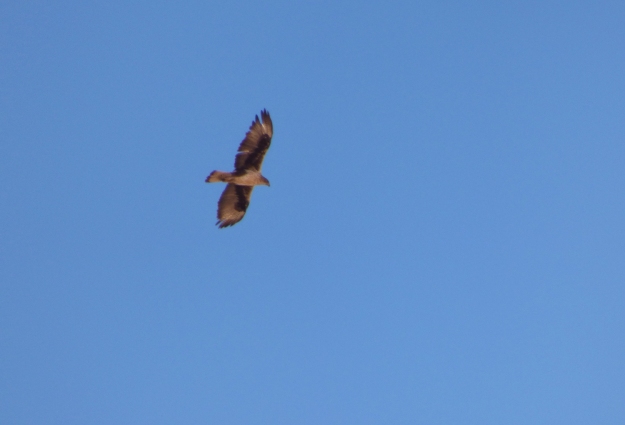
Bonelli’s Eagle (Aquila fasciata) is still a quite common raptor in Southern Morocco. Image by tour leader Carles Oliver
In the top of the Atlas we had some road birding with some Northern Wheatears, Mistle Thrushes, Common Kestrel, Common Raven and 5+ Booted Eagles appearing.
After this we celebrated our arrival to Marrakech with a wonderful dinner. That was the end of a wonderful 10 days, 10 nights trip with many, many birds and excellent views on all main targets! 190 species of birds seen and a lot of fun!!!
Also was the momment to pack everything and, for those staying in Marrakech, to start enjoying the city and the amazing cultural
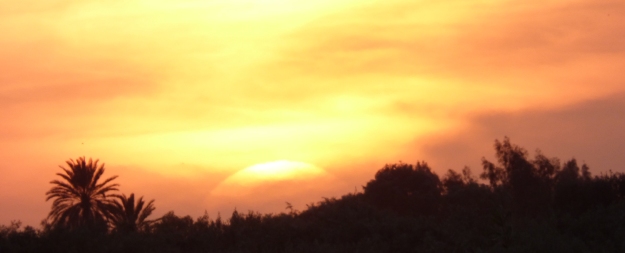
Sunset view in Marrakech, a wonderful way to finish our trip. Image by tour leader Carles Oliver
heritage of the whole country!!!
2018 trip is happening March 13th to March 22nd… YOU WANT TO MISS IT?






























